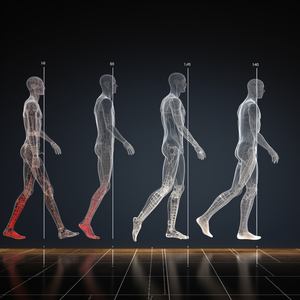The Intricacies of Human Gait: Exploring the Different Types of Walking Patterns
May 04, 2023
The human gait is a complex and fascinating process that involves the coordination of various muscles, joints, and the nervous system. Each individual has a unique walking pattern, which can be influenced by factors such as age, body structure, and overall health. In this blog post, we will delve into the world of human gait and explore some of the most common types of walking patterns observed in people.
Normal Gait
Before diving into the different types of walking patterns, it's essential to understand the basic components of a normal gait. A normal gait cycle consists of two main phases:- Stance phase: This phase accounts for approximately 60% of the gait cycle and occurs when the foot is in contact with the ground. It consists of several sub-phases, including heel strike, mid-stance, and toe-off.
- Swing phase: This phase makes up the remaining 40% of the gait cycle and occurs when the foot is not in contact with the ground. It begins with the toe-off and ends with the next heel strike.
Antalgic Gait
An antalgic gait is characterized by a shortened stance phase on the affected side due to pain. The individual may limp and shift their body weight to the unaffected side to minimize discomfort. This type of gait is often observed in people with hip, knee, or foot injuries.
Trendelenburg Gait
The Trendelenburg gait is caused by weakness or instability in the hip abductor muscles, which results in a tilting of the pelvis towards the unsupported side during the stance phase. This leads to an exaggerated lateral sway of the body and a characteristic "waddling" appearance.
Ataxic Gait
Ataxic gait is characterized by an unsteady, uncoordinated walking pattern with a wide base of support. Individuals with ataxia may have difficulty maintaining balance and may stagger or sway while walking. This type of gait is often seen in people with cerebellar disorders or sensory neuropathies.
Hemiplegic Gait
Hemiplegic gait occurs in individuals who have experienced a stroke or brain injury that affects one side of the body. This walking pattern is marked by a stiff, extended leg with circumduction (swinging the leg outward) and a flexed arm held close to the body.
Parkinsonian Gait
The Parkinsonian gait is typically seen in individuals with Parkinson's disease and is characterized by small, shuffling steps with reduced arm swing. Individuals with this gait pattern may also experience freezing episodes, where they are momentarily unable to initiate movement.
Steppage Gait
Steppage gait is characterized by an exaggerated lifting of the foot, often with the toes pointing downwards, to clear the ground during the swing phase. This walking pattern is typically associated with conditions that cause foot drop, such as peroneal nerve injury or muscular dystrophies.
The human gait is a complex and fascinating process, with numerous variations observed across individuals. Understanding these different types of walking patterns can aid healthcare professionals in diagnosing and treating underlying conditions that may be affecting an individual's mobility. It also highlights the intricate nature of human movement and the incredible adaptability of our bodies in the face of challenges.

